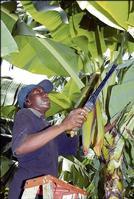
A worker at the Plunkett Farm in St. Mary takes care of a banana plant. - IAN ALLEN/STAFF PHOTOGRAPHER
WE ARE talking about the basis of the lives of all rural Jamaicans, and the basis of our self-esteem. "With my strong right hand, I am a banana man," no longer has much relevance for us. We produced 200,000 tons of bananas in 1965 and did about 150,000 in the 1970s and 1980s. Since then we have slipped to 42,000 tons in 2000; 43,000 tons in 2001; 39,386 tons in 2002; 39,936 tons in 2003 and 27,637 tons in 2004 and it will certainly not be better in 2005 with its two brushes with Hurricanes Dennis and Emily.
TECHNICAL ANALYSIS
It is obvious that a thorough assessment based on hard scientific, technical analysis, looking at every aspect of the industry - the soils, the varieties, the processing systems, the cost of credit, cost of transportation and the utilisation of the plant - is needed. In a word, God could not have ordained that Guadeloupe and Martinique can produce 20 tons per acre and the Jamaican farmer has to struggle to produce 8 tons per acre, despite the fact that Jamaica started the international industry in 1870 and was the world's largest exporter for 60 years, until 1939. Jamaica is short of fruit for export and even for our banana and plantain chip industry.
IN-DEPTH LOOK
The entire industry needs an objective in-depth look. The hillside farmers of St. Catherine need it. The St. Thomas and Portland farmers require it; the St. James growers are in deep trouble because it has not been done and the entire St. Mary has collapsed because it has not been done. St. Mary alone exported 40,000 tons every year in the 1960s - to be a St. Mary banana farmer, even a small farmer, was enough to gain unsecured credit at the bank. Another 130,000 tons of export fruit would have earned another US$50 million.









